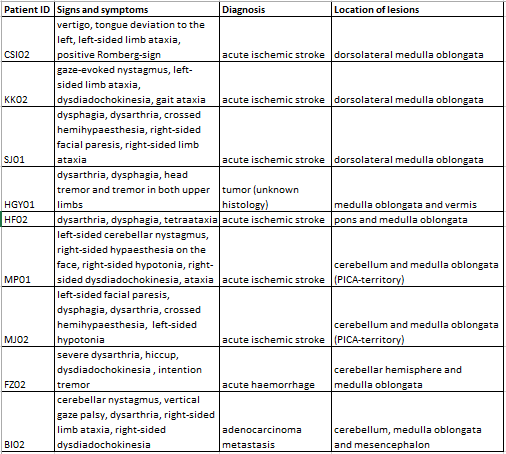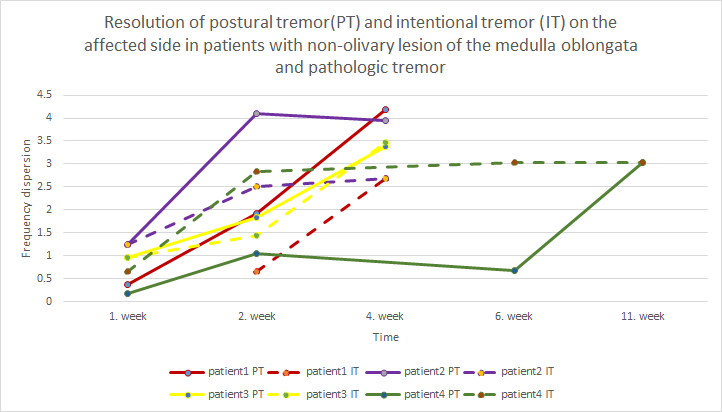Session Information
Date: Tuesday, June 6, 2017
Session Title: Tremor
Session Time: 1:45pm-3:15pm
Location: Exhibit Hall C
Objective: We examined the characteristics of tremor caused by lesions of the medulla oblongata, which do not affect the inferior olive.
Background: The medulla oblongata is functionally and structurally related to the cerebellum, and it is known that the inferior olive has a role in pathologic tremor generation probably through the dysfunction of the cerebellar connections. The characteristics of tremor caused by non-olivary lesions of the medulla oblongata have not been explored yet.
Methods: We analyzed quantitatively the tremor of 116 patients with brainstem and/or cerebellar lesions and here we report the results of 9 patients with dorso-lateral medulla oblongata lesion not involving the inferior olive (dlMO). Tremor was measured by biaxial accelerometry. Center frequency, frequency dispersion and tremor intensity were calculated. In 5 patients, control measurements were performed to assess the speed of recovery. Detailed analysis of the MRI data was performed by a neuroradiologist.
Results: Pathologic tremor was detected in 7/9 patients (77.8%). Three patients had isolated dlMO damage, one of these had pathologic tremor ipsilateral to the lesion. Six patients had lesions both in the dlMO and also in other parts of the brainstem or the cerebellum (Table 1). All these patients had pathologic tremor (Figure 1). The amplitude was only slightly higher than normal. Center frequency was 2.13±0.36 Hz. Frequency dispersion was 0.57±0.37 Hz. Follow-up measurements showed complete recovery of tremor in 4 weeks (Figure 2).
Conclusions: Non-olivary lesions of the medulla oblongata frequently cause symptomatic tremor, which has low amplitude and low frequency. Our results suggest that in the medulla oblongata a network rather than a single structure, like the inferior olive, plays role in the generation of pathologic tremor. The tremor caused by acute medulla oblongata lesion is reversible; the recovery is usually complete within 4 weeks. The reversible nature of symptomatic tremor highlights the differences in the pathomechanism compared to tremors caused by neurodegenerative diseases.
References: Rieder, C. R., et al. (2003). “Holmes tremor in association with bilateral hypertrophic olivary degeneration and palatal tremor: chronological considerations. Case report.” Arq Neuropsiquiatr 61(2b): 473-477.
Handforth, A. (2016). “Linking Essential Tremor to the Cerebellum-Animal Model Evidence.” Cerebellum 15(3): 285-298.
To cite this abstract in AMA style:
A. Kovács, N. Pintér, L. Halász, A. Kamondi. Characteristics of tremor caused by non-olivary lesion of the medulla oblongata [abstract]. Mov Disord. 2017; 32 (suppl 2). https://www.mdsabstracts.org/abstract/characteristics-of-tremor-caused-by-non-olivary-lesion-of-the-medulla-oblongata/. Accessed December 12, 2025.« Back to 2017 International Congress
MDS Abstracts - https://www.mdsabstracts.org/abstract/characteristics-of-tremor-caused-by-non-olivary-lesion-of-the-medulla-oblongata/


